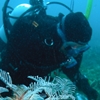General Description
Colony of individual polyps (hydranths) joined by root-like network of tubular stolons at the base. Colony shaped like a fan. Colour: stem and branches dark greyish brown, gonothecae white. Up to 30 cm high.
Biology
Colonies of this species live for several years. They are fertile in winter. They may also occur in New Zealand but this is yet to be confirmed.
Habitat
Deep reefs in flowing current.
Reefs
Distribution guide
Southern Australia.
Species Group
Depth
Shallow (1-30 m)
Deep ( > 30 m)
Water Column
Max Size
30 cm
Diet
Plankton or Particles
Harmful
Generally not harmful but still able to sting bare skin.
Commercial Species
No
Identify
Conservation Status
- DSE Advisory List : Not listed
- EPBC Act 1999 : Not listed
- IUCN Red List : Not listed






